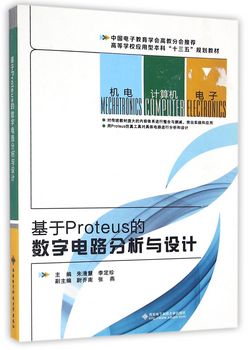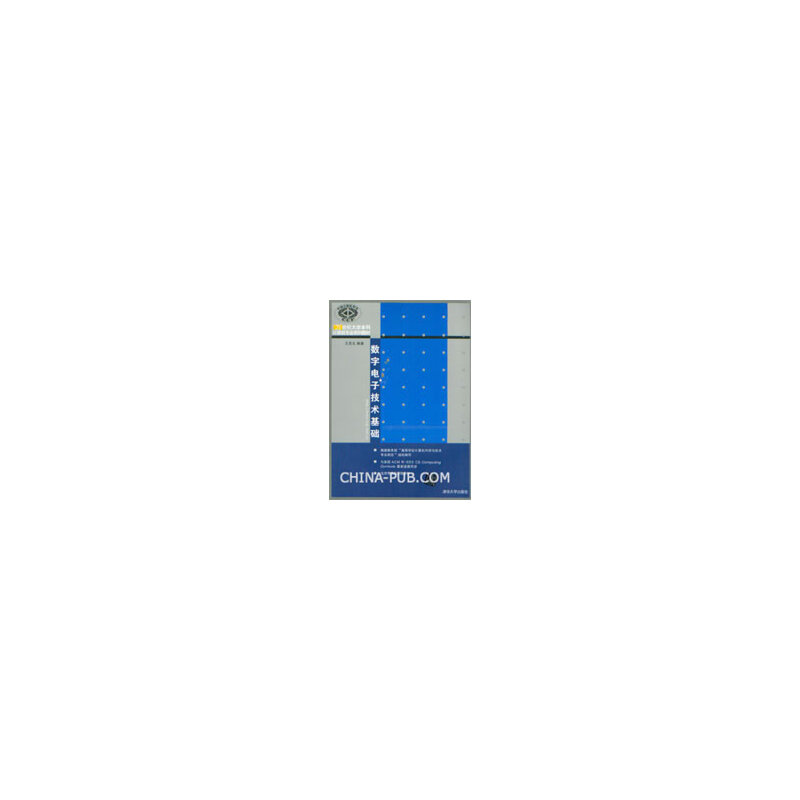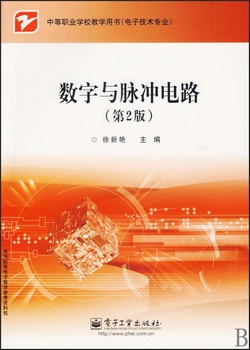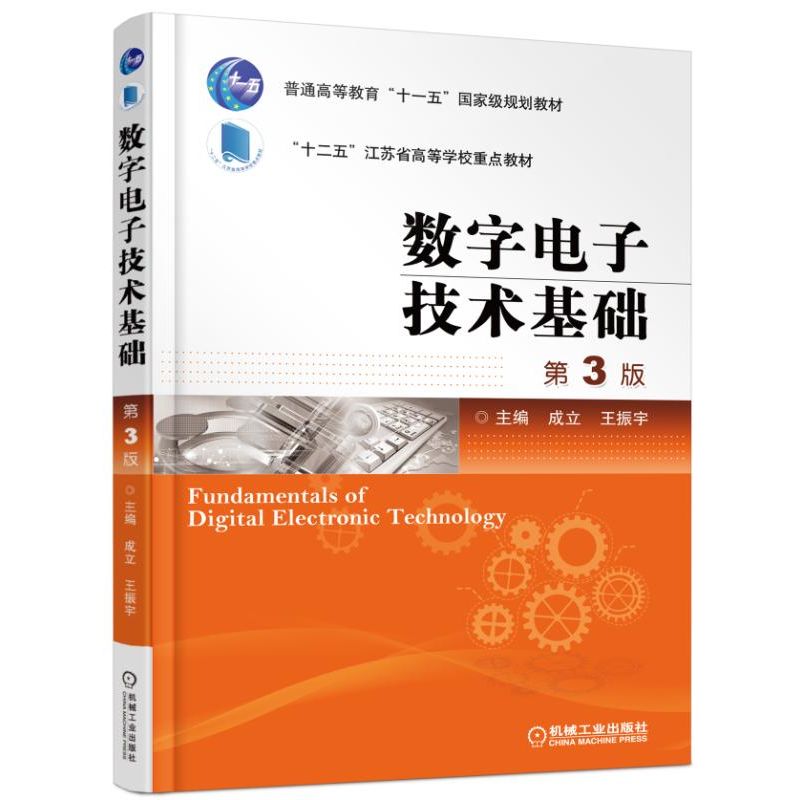朱清慧、李定珍主编的《基于Proteus的数字电路分析与设计》图文并茂、深入浅出地介绍了数字电路的有关知识。全书共分为9章,第1~4章为基础知识部分,主要介绍数字系统的概念、数制与码制、门电路以及组合逻辑代数;第5章为组合逻辑电路分析与设计,以Proteus为平台,以实际器件应用电路为载体进行电路分析;第6章和第7章分别为锁存器和触发器、时序逻辑电路的分析与设计,同样以Proteus为平台,介绍实际器件应用案例;第8章为脉冲波形发生器,介绍数字电路时钟波形的产生以及波形的整形;第9章介绍了模一数和数一模转换器。
本书可作为应用型本科院校计算机、机械、电子类等专业学生的数字电子技术基础教程,也可作为教师的教学参考用书,同时也可供从事电子线路设计的工程技术人员学习和参考。
图书详情 | 《基于Proteus的数字电路分析与设计》
图书分类 一 〉工学 一 〉电子科学与技术
- 西安电子科技大学出版社
- 9787560642116
- -
- 99034
- 0047177539-5
- -
- -
- -
- -
- -
- -
- -
- 工学
- 电子科学与技术
- 0809
- TN79
- 无线电电子学、电讯技术
- 本科
- 初版
- -
- -
- -
内容简介:
目录
第1章 数字系统的概念(Concept of Digital System)
1.0 概述(Introduction)
1.1 数字量和模拟量(Digital Quantity and Analog Quantity)
1.1.1 模拟量和模拟电信号(Analog Quantity and Analog Signal)
1.1.2 数字量和数字电信号(Digital Quantity and Digital Signal)
1.2 二进制数、逻辑电平和数字波形(Binary Numbers,Logic Levels and Digital Waveforms)
1.2.1 二进制数(Binary Numbers)
1.2.2 逻辑电平(Logic Levels)
1.2.3 数字波形(Digital Waveforms)
1.3 数据传输(Data Transmission)
1.4 基本逻辑运算(Basic Logic Operation)
1.5 基本逻辑功能(Basic Logic Function)
1.5.1 比较功能(Comparison Function)
1.5.2 算术功能(Arithmetic Function)
1.6 数字集成电路(Digital Integrated Circuit)
1.6.1 集成芯片封装(IC Package)
1.6.2 管脚序号(Pin Numbering)
1.6.3 集成电路分类(Integrated Circuit Classification)
1.6.4 集成电路技术(Integrated Circuit Technology)
第2章 数制与码制(The Numeration System and Code System)
2.0 概述(Introduction)
2.1 十进制数(Decimal Numbers)
2.2 二进制数(Binary Numbers)
2.2.1 二进制的表示方式(Binary Representations)
2.2.2 二进制的优点(Advantages of Binary)
2.2.3 二进制的波形图(Binary Waveform)
2.3 十进制一二进制转换(Decimal to Binary Conversion)
2.3.1 整数部分(Integral Part)
2.3.2 小数部分(Decimal Part)
2.4 十进制算术运算(Binary Arithmetic Operation)
2.4.1 二进制加法(Binary Addition)
2.4.2 二进制减法(Binary Subtraction)
2.4.3 二进制乘法和除法(Binary Multiplication and Division)
2.5 二进制数的反码和补码(One’s Complement and Two’s Complement of Binary Numbers)
2.5.1 有符号数(Signed Numbers)
2.5.2 反码和补码(One’s Complement and Two’s Complement)
2.5.3 补码的运算(Operation of Two’s Complement)
2.5.4 溢出(Overflow)
2.6 八进制数(Octal Numbers)
2.6.1 八进制数的表示方法(Representation of Octal Numbers)
2.6.2 八进制数与二进制数、十进制数之间的转换(Conversion of Octal Numbers into Binary Numbers&Conversion of 0ctal Numbers into Decimal Numbers)
2.7 十六进制数(Hexadecimal Numbers)
2.7.1 十六进制数的表示方法(Representation of Hexadecimal Numbers)
2.7.2 十六进制数与二进制数、十进制数之间的转换(Conversion of Hexadecimal Numbers into Binary Numbers&Conversion of Hexadecimal Numbers into Decimal Numbers)
2.8 BCD码(Binary-Coded Decimal)
2.9 格雷码和ASCII码(Gray Code and ASCII Code)
2.9.1 格雷码(Gray Code)
2.9.2 ASCII码(ASCII Code)
习题(Exercises)
第3章 门电路(Gate Circuit)
3.0 概述(Introduction)
3.1 三极管的基本开关电路(Basic Switching Circuit of Triode)
3.1.1 双极型三极管的基本开关电路(Basic Switching Circuit of BJT)
3.1.2 MOSFET基本开关电路(MOSFET Basic Switching Circuit)
3.1.3 TTL和CMOS的逻辑电平标准(Standard of TTL&CMOS Logic Levels)
3.2 TTL门电路的工作原理(Working Principle of TTL Gate Circuit)
3.2.1 TTL反相器(TTL Inverter)
3.2.2 TTL与非门(TTL AND-NOT Gate)
3.2.3 其它TTL门电路(Other TTL Gate Circuits)
3.3 CMOS门电路(CMOS Gate Circuit)
3.3.1 CMOS基本逻辑门电路(CMOS Basic Logic Gate Circuit)
3.3.2 带缓冲器的CMOS门电路(CMoS Gate Circuit with Buffer)
3.4 其它功能门电路(Gate Circuits of Other Functions)
3.4.1 CMOS传输门(CMOS Transmission Gate)
3.4.2 三态门(Three-state Gate)
3.4.3 集电极开路门(Open Collector Gate)
3.5 数字集成芯片实用常识(Practical Common Sense of Digital Integrated Chip)
3.5.1 数字集成芯片分类及命名(Classification and Nomenclature of Digital Integrated Chip)
3.5.2 数字集成芯片管脚的处理(Processing of Digital Integrated Chip Pin)
习题(Exercises)
第4章 组合逻辑代数(Combined Logic Algebra)
4.0 概述(Introduction)
4.1 布尔运算的定律和法则(Laws and Rules of Boolean Operation)
4.1.1 基本公式(Basic Formulas)
4.1.2 常用公式(Common Formulas)
4.1.3 逻辑代数的基本定理(Fundamental Theorem of Logical Algebra)
4.2 逻辑函数及其表示方法(Logic Function&It’s Representation)
4.2.1 逻辑函数(Logic Function)
4.2.2 逻辑函数的表示方法(Representation of Logic Function)
4.2.3 逻辑函数形式的转换(Conversion of Logic Function Forms)
4.2.4 标准与或式和标准或与式(Standard AND-OR Form&Standard OR-AND Form)
4.2.5 逻辑函数形式的变换(Variation of Logic Function Forms)
4.3 逻辑函数的化简方法(Approaches of Logic Function Simplification)
4.3.1 公式法化简(Simplifying Logic Algebra through Laws and Rules)
4.3.2 卡诺图法化简(Simplifying Logic Algebra through Karnaugh Maps)
4.4 具有约束的逻辑函数的化简(Simplification of Logic Function with Constraint)
4.4.1 约束项和约束条件(Constraint Term
1.0 概述(Introduction)
1.1 数字量和模拟量(Digital Quantity and Analog Quantity)
1.1.1 模拟量和模拟电信号(Analog Quantity and Analog Signal)
1.1.2 数字量和数字电信号(Digital Quantity and Digital Signal)
1.2 二进制数、逻辑电平和数字波形(Binary Numbers,Logic Levels and Digital Waveforms)
1.2.1 二进制数(Binary Numbers)
1.2.2 逻辑电平(Logic Levels)
1.2.3 数字波形(Digital Waveforms)
1.3 数据传输(Data Transmission)
1.4 基本逻辑运算(Basic Logic Operation)
1.5 基本逻辑功能(Basic Logic Function)
1.5.1 比较功能(Comparison Function)
1.5.2 算术功能(Arithmetic Function)
1.6 数字集成电路(Digital Integrated Circuit)
1.6.1 集成芯片封装(IC Package)
1.6.2 管脚序号(Pin Numbering)
1.6.3 集成电路分类(Integrated Circuit Classification)
1.6.4 集成电路技术(Integrated Circuit Technology)
第2章 数制与码制(The Numeration System and Code System)
2.0 概述(Introduction)
2.1 十进制数(Decimal Numbers)
2.2 二进制数(Binary Numbers)
2.2.1 二进制的表示方式(Binary Representations)
2.2.2 二进制的优点(Advantages of Binary)
2.2.3 二进制的波形图(Binary Waveform)
2.3 十进制一二进制转换(Decimal to Binary Conversion)
2.3.1 整数部分(Integral Part)
2.3.2 小数部分(Decimal Part)
2.4 十进制算术运算(Binary Arithmetic Operation)
2.4.1 二进制加法(Binary Addition)
2.4.2 二进制减法(Binary Subtraction)
2.4.3 二进制乘法和除法(Binary Multiplication and Division)
2.5 二进制数的反码和补码(One’s Complement and Two’s Complement of Binary Numbers)
2.5.1 有符号数(Signed Numbers)
2.5.2 反码和补码(One’s Complement and Two’s Complement)
2.5.3 补码的运算(Operation of Two’s Complement)
2.5.4 溢出(Overflow)
2.6 八进制数(Octal Numbers)
2.6.1 八进制数的表示方法(Representation of Octal Numbers)
2.6.2 八进制数与二进制数、十进制数之间的转换(Conversion of Octal Numbers into Binary Numbers&Conversion of 0ctal Numbers into Decimal Numbers)
2.7 十六进制数(Hexadecimal Numbers)
2.7.1 十六进制数的表示方法(Representation of Hexadecimal Numbers)
2.7.2 十六进制数与二进制数、十进制数之间的转换(Conversion of Hexadecimal Numbers into Binary Numbers&Conversion of Hexadecimal Numbers into Decimal Numbers)
2.8 BCD码(Binary-Coded Decimal)
2.9 格雷码和ASCII码(Gray Code and ASCII Code)
2.9.1 格雷码(Gray Code)
2.9.2 ASCII码(ASCII Code)
习题(Exercises)
第3章 门电路(Gate Circuit)
3.0 概述(Introduction)
3.1 三极管的基本开关电路(Basic Switching Circuit of Triode)
3.1.1 双极型三极管的基本开关电路(Basic Switching Circuit of BJT)
3.1.2 MOSFET基本开关电路(MOSFET Basic Switching Circuit)
3.1.3 TTL和CMOS的逻辑电平标准(Standard of TTL&CMOS Logic Levels)
3.2 TTL门电路的工作原理(Working Principle of TTL Gate Circuit)
3.2.1 TTL反相器(TTL Inverter)
3.2.2 TTL与非门(TTL AND-NOT Gate)
3.2.3 其它TTL门电路(Other TTL Gate Circuits)
3.3 CMOS门电路(CMOS Gate Circuit)
3.3.1 CMOS基本逻辑门电路(CMOS Basic Logic Gate Circuit)
3.3.2 带缓冲器的CMOS门电路(CMoS Gate Circuit with Buffer)
3.4 其它功能门电路(Gate Circuits of Other Functions)
3.4.1 CMOS传输门(CMOS Transmission Gate)
3.4.2 三态门(Three-state Gate)
3.4.3 集电极开路门(Open Collector Gate)
3.5 数字集成芯片实用常识(Practical Common Sense of Digital Integrated Chip)
3.5.1 数字集成芯片分类及命名(Classification and Nomenclature of Digital Integrated Chip)
3.5.2 数字集成芯片管脚的处理(Processing of Digital Integrated Chip Pin)
习题(Exercises)
第4章 组合逻辑代数(Combined Logic Algebra)
4.0 概述(Introduction)
4.1 布尔运算的定律和法则(Laws and Rules of Boolean Operation)
4.1.1 基本公式(Basic Formulas)
4.1.2 常用公式(Common Formulas)
4.1.3 逻辑代数的基本定理(Fundamental Theorem of Logical Algebra)
4.2 逻辑函数及其表示方法(Logic Function&It’s Representation)
4.2.1 逻辑函数(Logic Function)
4.2.2 逻辑函数的表示方法(Representation of Logic Function)
4.2.3 逻辑函数形式的转换(Conversion of Logic Function Forms)
4.2.4 标准与或式和标准或与式(Standard AND-OR Form&Standard OR-AND Form)
4.2.5 逻辑函数形式的变换(Variation of Logic Function Forms)
4.3 逻辑函数的化简方法(Approaches of Logic Function Simplification)
4.3.1 公式法化简(Simplifying Logic Algebra through Laws and Rules)
4.3.2 卡诺图法化简(Simplifying Logic Algebra through Karnaugh Maps)
4.4 具有约束的逻辑函数的化简(Simplification of Logic Function with Constraint)
4.4.1 约束项和约束条件(Constraint Term
















